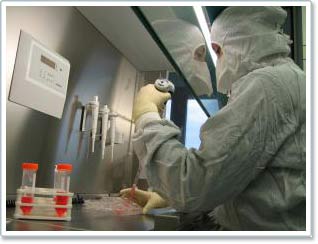Implants artificial skin from hair roots
Patients with chronic wounds have a new hope: euroderm GmbH and Fraunhofer Association for Cell Therapy and Immunology (IZI) in Leigzig have been approved to produce artificial skin from cells of patients themselves.
It sounds like a science fiction story: Spit someone's hair, and from 4 to 6 weeks later they turn into a piece of skin. Of course, what the Fraunhofer researchers on Cell Therapy and Immunology (IZI) in Leigzig are doing in their new 'cleanroom' is not so simple. "We and euroderm GmbH have been allowed to implant skin tissue in the transplantation of chronic wounds such as open sores in the legs of diabetics," said IZI researcher Dr. Gerno Schmiedeknecht . '
Currently, chronic wounds treated with skin grafts are usually taken from the thigh skin. This method leaves scars on both the thighs and the treated wound. Dr. Andreas Emmendörffer - executive director of euroderm GmbH said: 'If we manufacture recent leather using approved technology called EpiDex , we can achieve opportunities for recovery. recovery without hurting patients. Moreover, artificial skin implanted on the wound will not leave a scar. '

Patients with chronic wounds have a new hope: Medical researchers have been approved to produce artificial skin from patients' own cells.(Photo: Fraunhofer-Gesellschaft)
Another advantage is that transplants can be performed in outpatients. A few days later, we were able to see if the new skin was attached to the wound. 72 days later, it will be impossible to distinguish the skin from normal healthy skin.
But how do you know exactly how new skin develops? Emmendörffer explains: 'We pluck a few hairs from the patient's head and extract mature stem cells from their hair roots, then reproduce them with cell culture for about two weeks. Next, we reduced the amount of nutrient dissolved until it no longer covered the outer surface of the cells, then exposed the cells to outside air. Increased pressure due to pressure by oxygen on the surface will make them different from normal skin. '
In this way, researchers can replicate small pieces of skin, produced individually for each individual to add a surface range of 10 to 100 centimeters when the skin pieces are joined. To ensure that they always follow safety rules, researchers are using new clean rooms (Cleanroom) in IZI, this is the latest means of producing cell cures. different. Schmiedeknecht said: 'We continue to limit the number of dust particles in clean rooms. If there is too much dust in the air, a warning will occur. '
The researchers plan to develop skin transplants for 10 to 20 patients in a month in 2008, depending on how many doctors perform this method.
THANH TAM
- Artificial skin has hair and sweat glands
- Artificial skin feels real
- Artificial skin from microalgae, provides oxygen to help wounds heal
- The concept of women possessing naturally curly hair is very difficult, is this true?
- Spider silk can save burns
- Artificial hair follicles help treat hair loss
- Chinese doctor implants the ear in the patient's hand
- 4 reasons for early gray hair that you never thought about
- Stress makes silver hair
- Detects genes that regenerate hair and skin
- Scientists have developed artificial skin that feels like real leather
- Artificial skin feels real
 Green tea cleans teeth better than mouthwash?
Green tea cleans teeth better than mouthwash? Death kiss: This is why you should not let anyone kiss your baby's lips
Death kiss: This is why you should not let anyone kiss your baby's lips What is salmonellosis?
What is salmonellosis? Caution should be exercised when using aloe vera through eating and drinking
Caution should be exercised when using aloe vera through eating and drinking